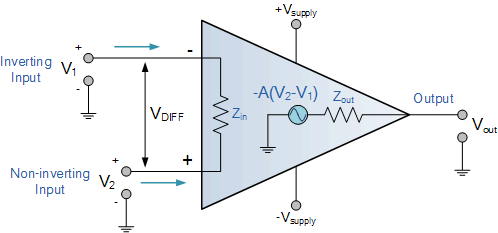Headroom is a buzzword in almost all areas of the audio universe. But what is it actually and is it important to you? I'll try to explain this in this blog and try to keep the techy stuff to a minimum, but yeah there will be some tech stuff!

Fig 1. Clipping
To begin with you will need to know the basics about an Op Amp and the rules it theoretically adheres to. I will stick to the Op Amp and not go into the theory of transistors. I promised to keep the tech stuff as low as possible.
An Operational Amplifier (=Op Amp) has 2 inputs and 1 output supported by a single or dual supply rail formed by V+ and V-. An ideal Op Amp adheres to a set of rules from which I will only quote 3.
Current rule: No current flows in or out either input terminal
Voltage rule: The differential input offset voltage (Vdiff) is zero
Gain rule: An ideal Op Amp has infinite open-loop gain.
Got it?

Fig 2. Operational Amplifier
So if you just put a signal on an Op Amp it will amplify it infinitely (actually a real Op Amp will amplify it about 100dB depending on the type of Op Amp... consult the datasheet!). In theory a simple Op Amp would be able to scream the ears off every living being on earth (and the universe for that if it was not a vacuum) and be the most feared weapon know to man. So, why does that not happen?
Well, because the Op Amp has a boundary that the signal can not exceed the bandwidth formed by V+ and V-. Else it will start clipping, which is a nice word for cutting of the signal. Well, how does that look? Take a look at figure 1.
To make an Op Amp useful we need to "tame" it so it sticks within it's bandwidth. Or do we? Clipping is ok, right?
Now, what is headroom?
"Headroom is a measure of how close the input and output of an amplifier can swing to the supply rails."
In a most guitar pedal "headroom" would be between 0V (ground) and +9V. Your in- and output signals will need to be within this bandwidth not to clip.
Now we have a small problem.... what if the voltage of a signal gets negative?? A guitar signal is bipolar, right? There is nowhere to go under 0V since V- = ground = (approx) 0V. For this you will need an "offset" or "bias" at the input so you bump the signal to above V- and form another buzzword... "virtual ground". (PS If you are in doubt that guitar signals go negative and so are bipolar, I'll go into pickups and inductance at an other time.)
You see this bias voltage a lot in pedal schematics where the +9V is first filtered by a few capacitors and then split in 2 by a voltage divider to form Vb. Most common is the Vb = 1/2 V+. Like this:

Do not worry about the signal not fitting this bandwidth. Guitar signals (unamplified) do not exceed the 4.5V. So what do we have up to this point? A signal that can fit the headroom. I say "can" because if you do not tame the Op Amp beast it will, as you now know, theoretically amplify infinitely and clip the whole signal.

If you can increase the bandwidth between V+ and V- then you will increase the headroom. Great, but why?
Well for one thing it will give you the ability to amplify the signal more before it starts to break up (=clip). So overdrive/distortion/clipping will start only at a higher amplification.
This is why a bigger headroom is especially nice for clean signal application and less for overdriven/distortion application. You will note more clarity/transparancy in higher headroom effects as all the frequencies can be amplified more before breaking up.
This is why I would not immediately suggest a charge pump in a distortion, but I would for a tremolo, chorus and overdrive. And he... that never stopped me from adding a chargepump to an effect!
O and one more thing. Some could ask, "why not use a 1000V charge pump?" Well, for a lot of reasons, but mostly because an Op Amp can only take so much. If you look at the datasheet of the common TL072 it is recommended to be used between -15V (Vcc-) and +15V (Vcc+). That is not the max, but 1000V would kill it.
Contact me
Got any questions or additions or even a rant? Contact me and maybe I'll blog about it.


Add comment
Comments